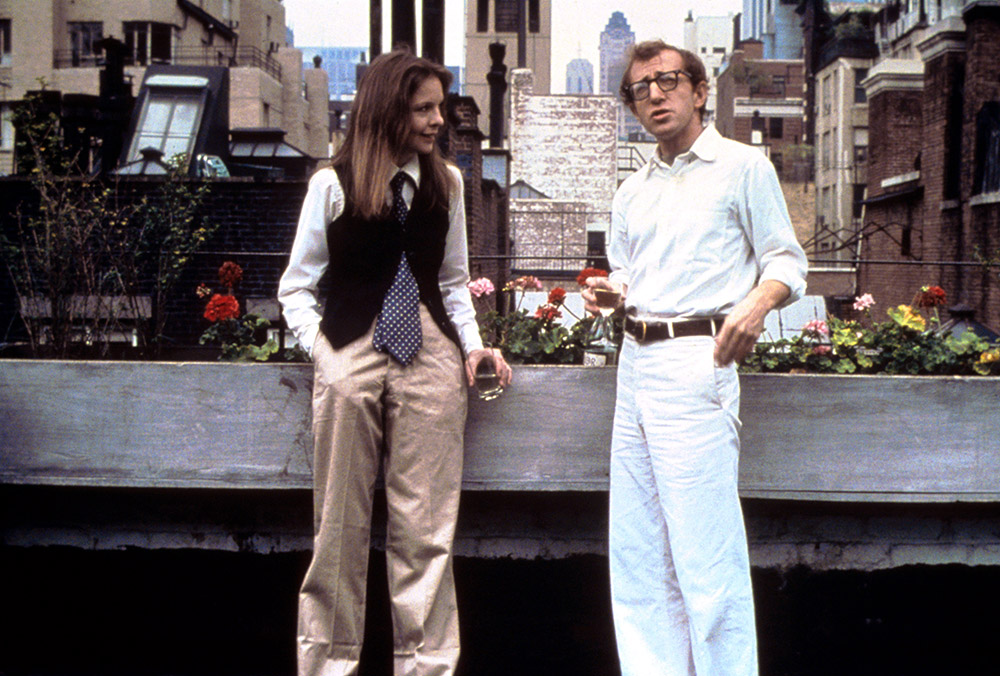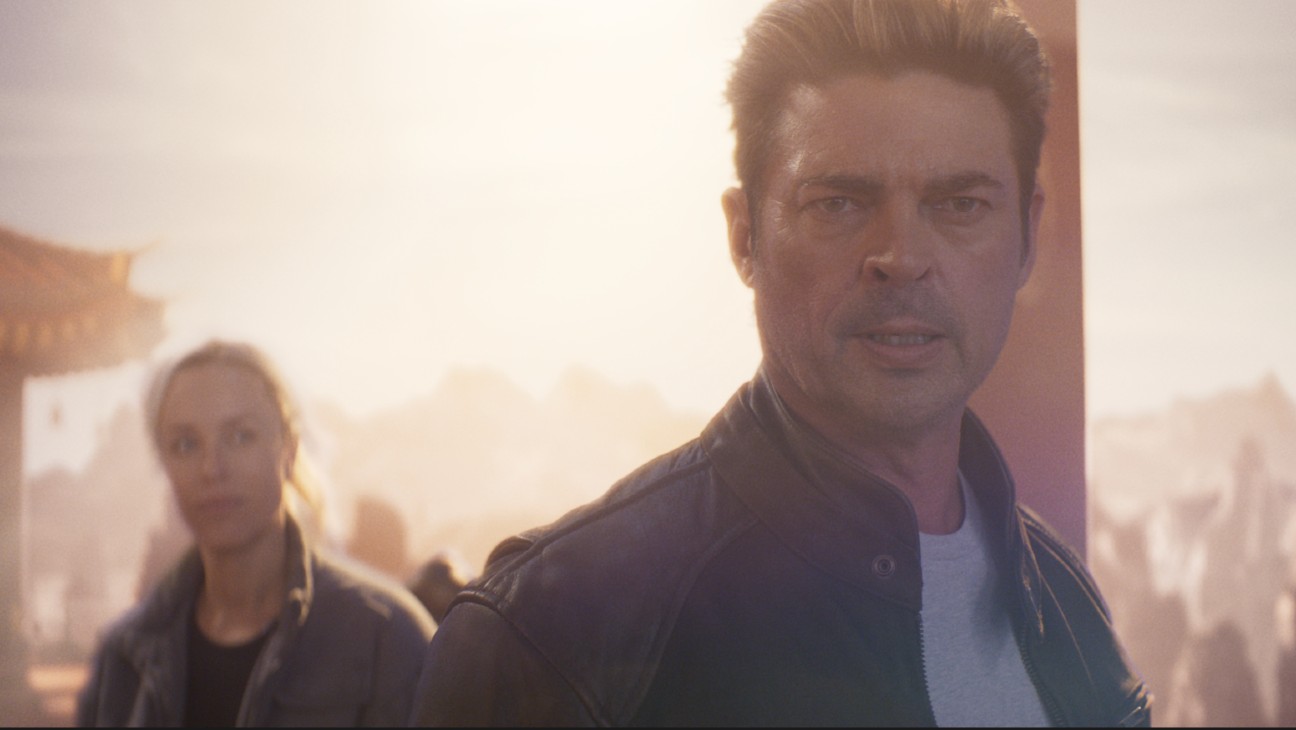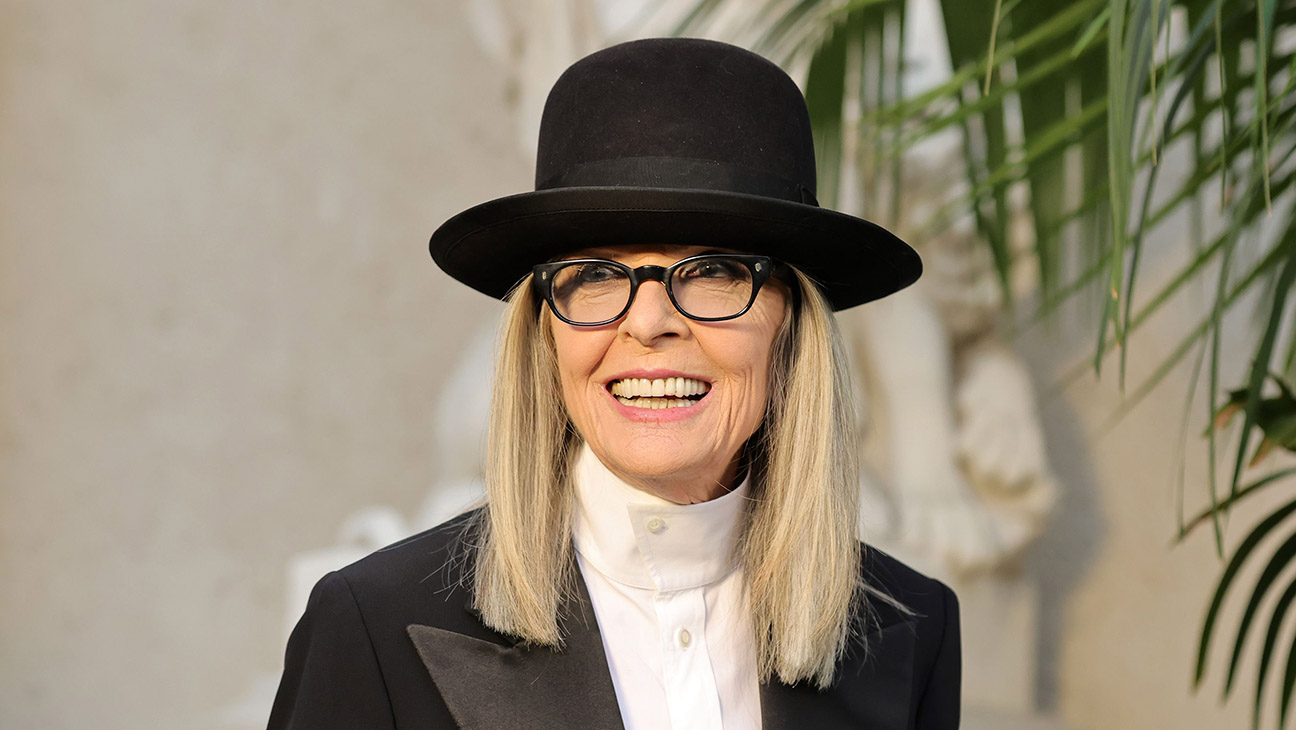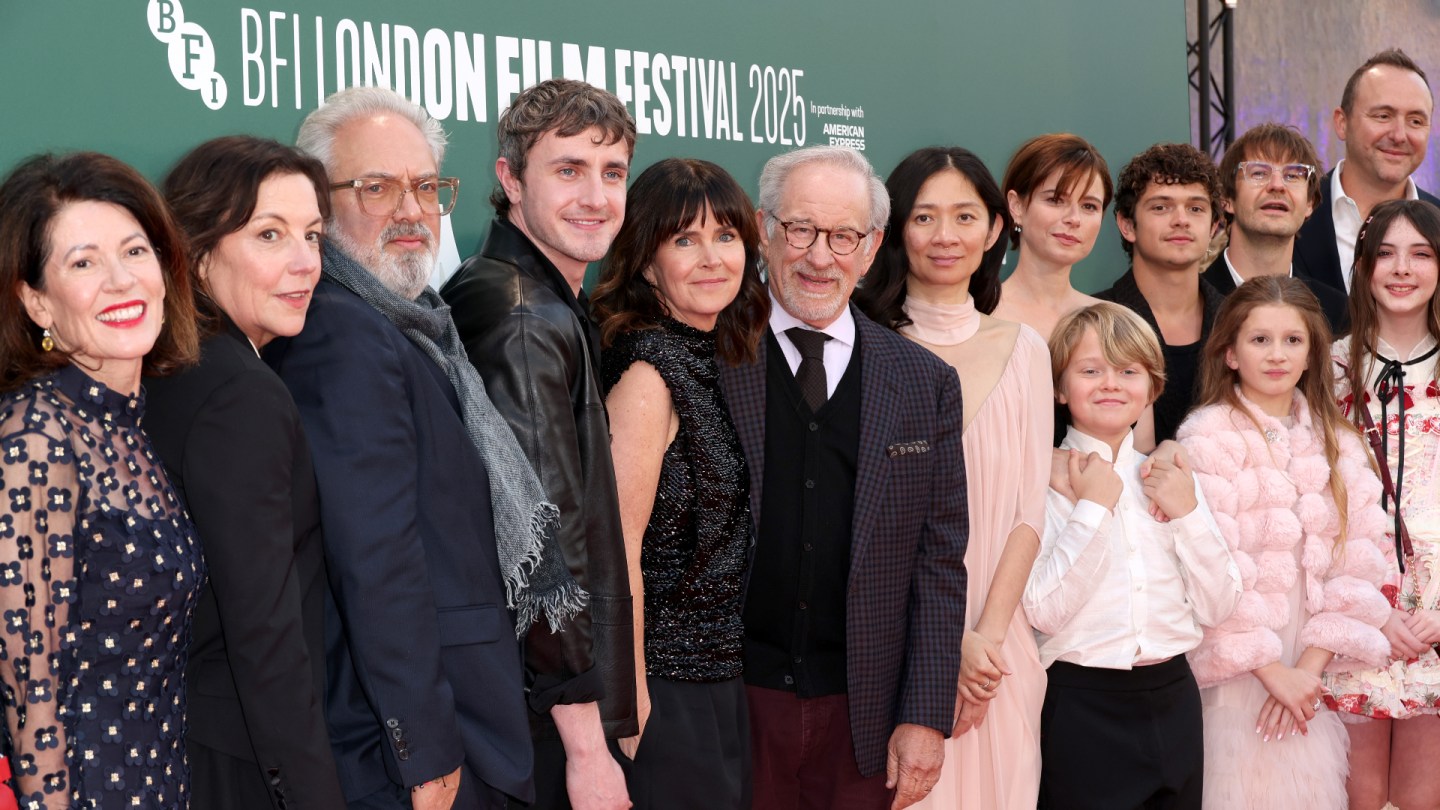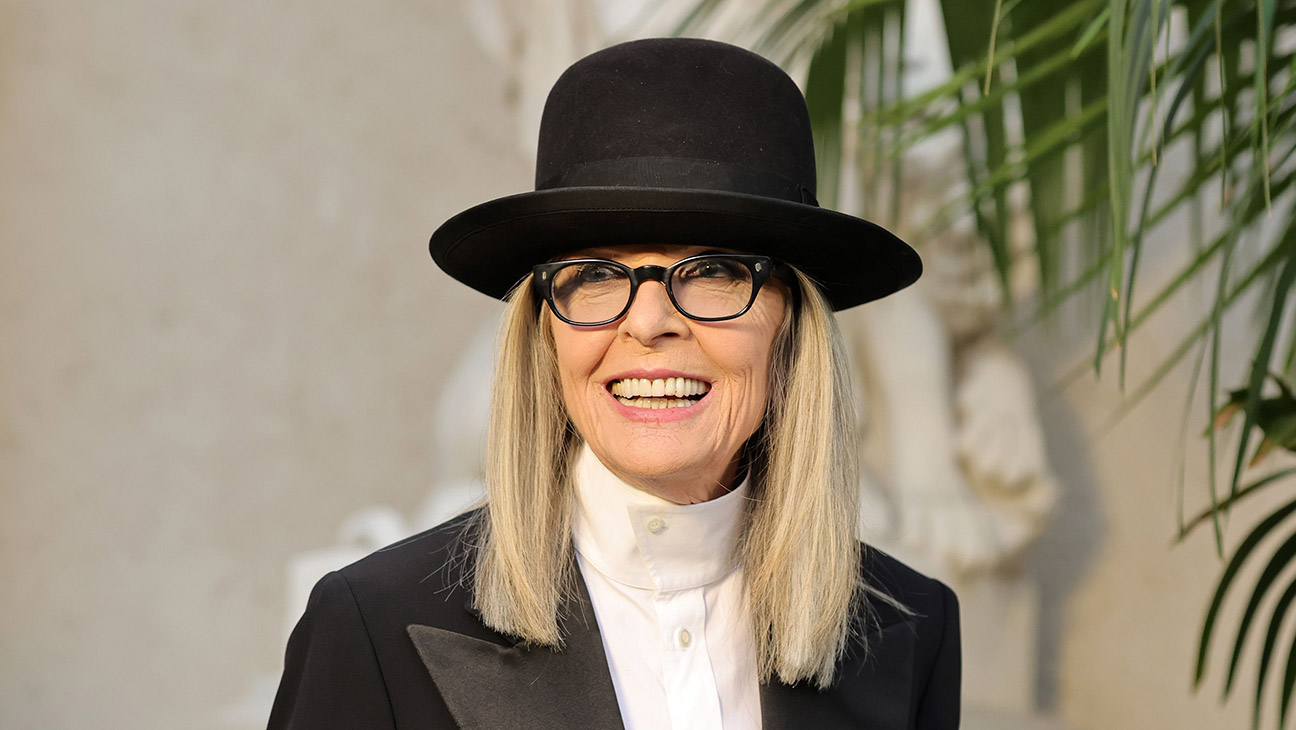There’s a very funny scene in Ron Howard’s frothy 1984 interspecies rom-com, Splash, in which Daryl Hannah, playing a mermaid in Manhattan who swaps her tail for legs, skips out to buy suitable land attire. Given that she emerged from the sea naked, she throws together an outfit from the Tom Hanks character’s closet.
The “fish out of water” turns up on a Bloomingdale’s womenswear floor in a men’s black suit, white shirt, black leather derbies and what looks like a school tie. The ensemble instantly brings a horrified saleslady scurrying over: “Oh my God, darling, darling, darling! That outfit is to die from! What happened, you saw Annie Hall a hundred times? That look is over.”
That was seven years after the release of Annie Hall and the imprint on fashion and popular culture of Diane Keaton’s iconic looks as the title character remained an instantly identifiable reference.
Even more than Marlene Dietrich had done in white tie and tuxedo ensembles in the 1930s, Keaton in Annie Hall kickstarted a wave of genderless dressing with her men’s shirts and wide ties, slouchy trousers and oversized jackets, button-up vests and fedoras.
What made the layered wardrobe trend resonate — and continue to be seen on stylish women today — was how effortlessly cool it looked on Keaton. Her outfits were eccentric but unfussy, tomboyish but distinctly feminine. They made her character appear confident, even at her most insecure. And while the costumes mostly came from shopping expeditions to Ralph Lauren and other menswear emporiums, they were 100 percent reflective of Keaton’s personal style off-camera.
The misconception that comedy is easy — and that Keaton was essentially playing a version of herself — caused some quiet ripples of discontent when she beat out competition that included Anne Bancroft, Jane Fonda and Shirley MacLaine in dramatic roles to take home the best actress Oscar in 1977.
But Keaton’s justly honored performance in Annie Hall endures for reasons that go far beyond the synthesis of her on- and offscreen personas. She essentially reinvented the classic screwball heroine for a more socially evolved age. Annie might have come off to a casual observer as a kookie ditz, but she was clever, witty, talented, a sponge for knowledge and, eventually, an assertive voice for her own independence.
She emerged with a wave of actresses in the 1970s and early ‘80s that defied traditional standards of silver-screen glamour by being utterly natural, among them Karen Allen, Brooke Adams, JoBeth Williams, Jill Clayburgh and Margot Kidder. And yet Keaton was very much an original, never part of any pack.
The announcement of her unexpected death at 79, less than a month after Robert Redford’s passing, represents another stinging loss to the pantheon of New Hollywood in the decades before the major studios largely stepped away from making movies for grownups.
Irrespective of your views on the now-controversial figure of Woody Allen, the films he made with Keaton, both during and after their romantic involvement, remain among her most outstanding screen work — Annie Hall and Manhattan in particular.
That’s at least partly because while Keaton’s characters might have been amused by the brainy verbosity and self-effacing neuroses of Allen’s alter egos, she was never intimidated or outmatched by them. She challenged her writer-director and co-star in ways that few other women in his movies ever have.
Keaton’s innate radiance and verve made her born to play comedy, but she was no less gifted a dramatic actor. The women in Francis Ford Coppola’s Godfather trilogy are generally submissive. But Keaton made Kay Adams-Corleone — an initially naïve outsider, favoring love over clarity as she agrees to marry Al Pacino’s Michael Corleone — the moral tether to the outside world, beyond the vicious criminal enterprises of the Mafia dynasty. She stands up to Michael and walks away, as few others get to do.
The same year Annie Hall was released, Keaton took on a risky role for a rising-star actress in Looking for Mr. Goodbar. In a fearless performance, she played Theresa Dunn, a dedicated schoolteacher whose repressive Catholic upbringing and history of childhood illness become fuel for her defiant sexuality. After feeling used and disrespected in her first experiences with men, Theresa throws herself into an increasingly dark spiral of sleazy pickup bars and hookups with strangers, ultimately with fatal results.
With a lesser interpreter, the movie might have been just a sensationalistic shocker, but Keaton brought integrity and emotional candor to Theresa’s messy search to define herself. That made it a rare example for its time of a character study that explored a modern woman’s erotic desires without shame.
Keaton was tough, impassioned and ultimately heartbreaking as feminist journalist and Russian Revolution sympathizer Louise Bryant, starring opposite writer-director (and offscreen partner at the time) Warren Beatty as Bohemian communist activist John Reed in his 1981 historical epic, Reds.
But her crowning dramatic achievement came arguably the following year in Alan Parker’s raw, unflinching depiction of marital breakdown Shoot the Moon, starring opposite Albert Finney. In an ecstatic New Yorker review, Pauline Kael described their characters as torn from inside the writer, director and the two stars. Faith Dunlop was a role that allowed Keaton to embrace both depression and steadfast self-possession, refusing to endure more pain from the man she married, even at the cost of great distress to their children.
“Diane Keaton acts on a different plane from her previous film roles,” wrote Kael. “She brings the character a full measure of dread and awareness, and does it in a special, intuitive way that’s right for screen acting. Nothing looks rehearsed, yet it’s all fully created.”
Aside from Paolo Sorrentino, who gave Keaton red meat to chew on as the formidable American nun and spiritual consigliere in the HBO series The Young Pope, it’s disappointing that in the later years of her six-decade career, directors mostly stopped challenging Keaton.
More often they leaned on her signature quirks and mannerisms, at times pushing her to the point of self-caricature. But Keaton could shine even in humdrum material and there are gems among the many cute comedies she could do with her hands tied behind her back.
One such keeper is The First Wives Club, an effervescent feminist revenge comedy in which Keaton, Goldie Hawn and Bette Midler play women pushed aside for younger models who turn the tables on their philandering husbands. Another is the role that landed Keaton her fourth Oscar nomination, in Something’s Gotta Give, Nancy Meyers’ advanced-age romantic comedy. She stars as a whip-smart playwright who’s much more than a foil to Jack Nicholson’s smug playboy, who prides himself on dating only women under 30.
With her sheer, undiminished magnetism alone, Keaton remained a feisty rebuke to that kind of ageism in Hollywood. Her vitality was unextinguishable. We are fortunate to have shared so much of her life.

